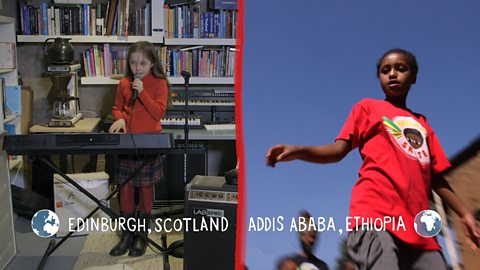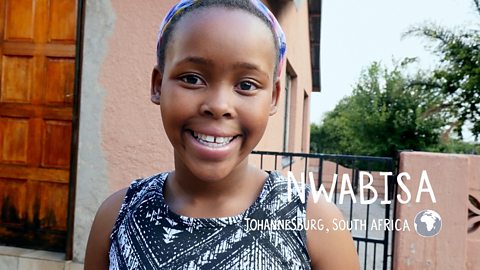This collection of Funky Facts from Go Jetters focuses on Africa, a vast continent spanning the Equator and containing more than fifty countries and many different climate zones and landscapes.
The overview clip below summarises the continent in simple terms whilst hinting at its diversity and wonder.
The other clips reveal facts from other parts of this huge continent including:
- Egypt, in the north of this continent, famed for its ancient pyramids
- Democratic Republic of Congo in central Africa, home to the mountain gorillas of Virunga National Park.
- Kenyaβs Maasai Mara to the east, with its famed mass annual wildebeest migration.
- To the south, Table Mountain, a flat-topped mountain overlooking South Africaβs capital city, Cape Town.
These brief selections provide a useful, contrasting set of locations to help introduce this enormous continent to pupils.
Supporting resource from Twinkl
This collection is supported by a free teaching resource from .
Download for free using the link below:
Africa
Maasai Mara, Kenya
Pyramids of Giza, Egypt
Table Mountain, South Africa
Virunga National Park, Central Africa
Two children's lives in Edinburgh and Addis Ababa. video
In this short film for primary pupils Rose from Edinburgh and Eden from Addis Ababa tell us about life in their respective cities.

Two children's lives in Birmingham and Johannesburg. video
In this short film for primary pupils Sulaiman and Nwabisa tell us about their lives on the outskirts of two sprawling cities: Birmingham and Johannesburg.

Teacher Notes
Before Watching
Discuss or remind pupils what a landmark is and talk about what makes a feature special and why. Ask pupils if they can name any famous landmarks.
Ask pupils if they can say what Africa is. Explain that it is one of several continents that make up the world. Discuss the meaning of continent and show these on a globe or 2D map of the world.
Find out what pupils already know about Africa. Note negative comments and misconceptions as well as generalisations and stereotypical thinking and be prepared to challenge these when you start to investigate facts about its diverse people and landscapes.
Play games using a blow-up globe: throw it to pupils and ask them to name and locate a country in Africa when they catch it. You could vary this and encourage them to ask their own questions such as: Point to a country in Africa that is north of the Equator / on the Equator, that shares a border with Kenya, touches the Mediterranean Sea etc.
After Watching
Find Africa in an atlas and use the scale bar to measure how long and wide this continent is. Discuss how vast this area is relative to the size of other places, such as Australia.
Gather a collection of varied images that all show people and places in Africa. Ask pupils to sort them and say whether they think all are from Africa or not. Ensure that the images show a wealth of diversity, from traditional mud-built homes to skyscrapers, deserts to snow-topped Kilimanjaro, rural villages, to modern city streets, people in traditional and non- traditional dress etc.Discuss the results and pupilsβ ideas.
Read a selection of story and non-fiction books set in different countries in Africa and locate places on a map.
Use a large outline map of the continent and ask pupils to add drawings or images of physical features such as deserts, rivers, mountains and lakes. Use atlases to help with this. You could also do this in collage.
Ask pupils to work in groups to create their own funky fact booklets about Africa and use atlases to research information. Allocate a country to each group or let pupils choose their own. You might for example, choose Egypt, Kenya, and South Africa as these countries feature in the other clips.
βZoomβ into a local scale and select a place to compare with where you live. For example, you might choose a village or town in Kenya. Look at the everyday lives of the people who live there and draw out similarities and difference with pupilsβ everyday lives.Can pupils find β¦? Ask pupils to ask each other questions about Africa using an atlas e.g. βCan you find a large / small country?β, ββ¦a long river?β Etc.
Master Skills
- Naming, describing and comparing people and places (people, landmarks and features).
- Locating landmarks and features using paper or digital maps; globes and atlases.
- Drawing comparisons and similarities between places.
Thinking Question
- What is the continent of Africa like?
Supported Learning and SEN
Children could work in pairs or mixed ability groupings so that they benefit from peer support.
Using photographs to sort and talk about ideas can help some pupils express their thoughts more easily.
Use vocabulary cards to match to what can be seen and support language development.
Pupilsβ ideas might be recorded using audio or video media as well as through writing.
Extend This Project
Watch the full ten- minute Go Jetter film on Africa in which the Go Jetters go on a cross continental adventure. Work with pupils to locate and map the different places visited in the video.
Watch the other films in this collection. Map and compare the places shown, drawing out similarities and differences.
These short film clips contribute to the current national curriculum requirements in KS1 geography in England; the Foundation Stage World Around Us in Northern Ireland; the Foundation Phase Knowledge and Understanding of the World in Wales, and at Social Studies 1st level in Scotland.
The clips are especially pertinent to the Areas of Learning and subject requirements of geography but also provide opportunities to develop English and mathematics knowledge and skills in meaningful contexts across all UK curricula.
These clips and ideas will help develop pupilsβ curiosity and build on their early experiences of the world around us.
The clips and ideas contribute to UK curricular aspects relating to cultural understanding, particularly with regard to people and places.